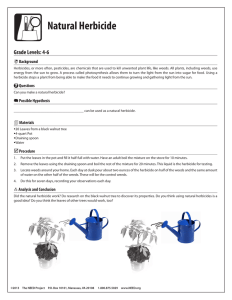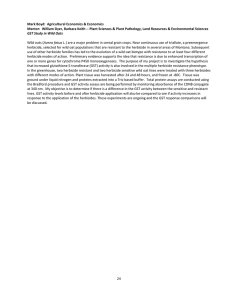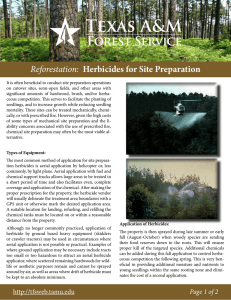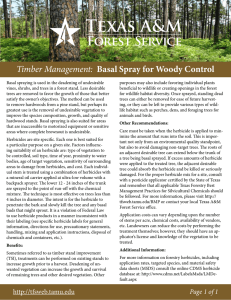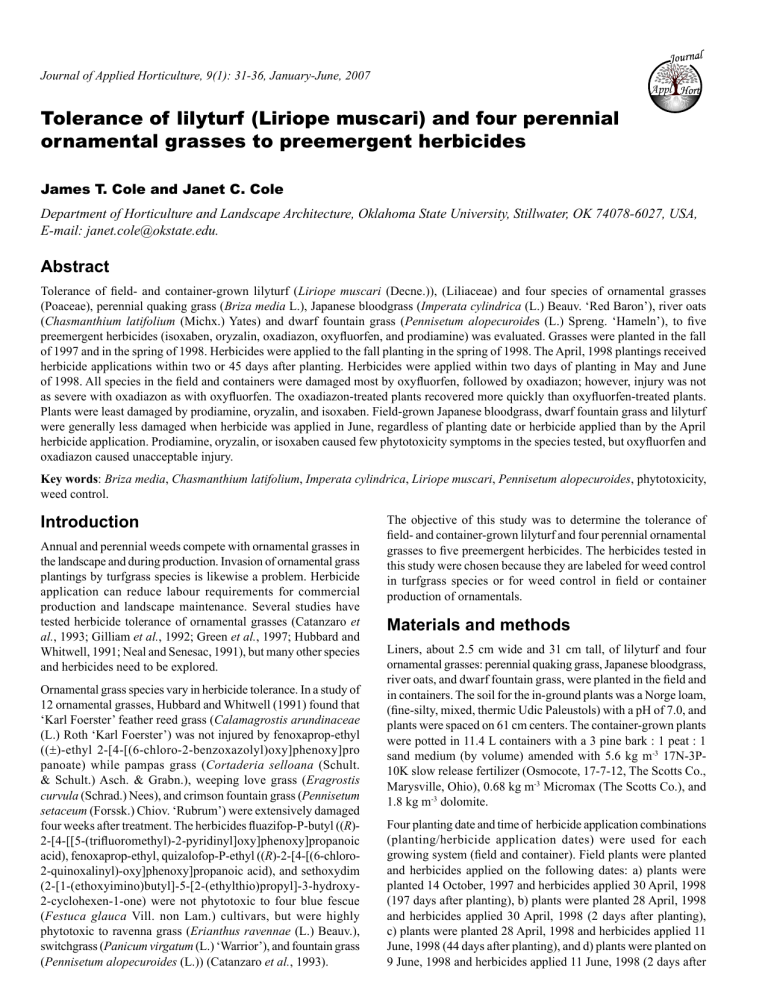
Journal of Applied Horticulture, 9(1): 31-36, January-June, 2007 Appl Tolerance of lilyturf (Liriope muscari) and four perennial ornamental grasses to preemergent herbicides James T. Cole and Janet C. Cole Department of Horticulture and Landscape Architecture, Oklahoma State University, Stillwater, OK 74078-6027, USA, E-mail: janet.cole@okstate.edu. Abstract Tolerance of eld- and container-grown lilyturf (Liriope muscari (Decne.)), (Liliaceae) and four species of ornamental grasses (Poaceae), perennial quaking grass (Briza media L.), Japanese bloodgrass (Imperata cylindrica (L.) Beauv. ‘Red Baron’), river oats (Chasmanthium latifolium (Michx.) Yates) and dwarf fountain grass (Pennisetum alopecuroides (L.) Spreng. ‘Hameln’), to ve preemergent herbicides (isoxaben, oryzalin, oxadiazon, oxyuorfen, and prodiamine) was evaluated. Grasses were planted in the fall of 1997 and in the spring of 1998. Herbicides were applied to the fall planting in the spring of 1998. The April, 1998 plantings received herbicide applications within two or 45 days after planting. Herbicides were applied within two days of planting in May and June of 1998. All species in the eld and containers were damaged most by oxyuorfen, followed by oxadiazon; however, injury was not as severe with oxadiazon as with oxyuorfen. The oxadiazon-treated plants recovered more quickly than oxyuorfen-treated plants. Plants were least damaged by prodiamine, oryzalin, and isoxaben. Field-grown Japanese bloodgrass, dwarf fountain grass and lilyturf were generally less damaged when herbicide was applied in June, regardless of planting date or herbicide applied than by the April herbicide application. Prodiamine, oryzalin, or isoxaben caused few phytotoxicity symptoms in the species tested, but oxyuorfen and oxadiazon caused unacceptable injury. Key words: Briza media, Chasmanthium latifolium, Imperata cylindrica, Liriope muscari, Pennisetum alopecuroides, phytotoxicity, weed control. Introduction Annual and perennial weeds compete with ornamental grasses in the landscape and during production. Invasion of ornamental grass plantings by turfgrass species is likewise a problem. Herbicide application can reduce labour requirements for commercial production and landscape maintenance. Several studies have tested herbicide tolerance of ornamental grasses (Catanzaro et al., 1993; Gilliam et al., 1992; Green et al., 1997; Hubbard and Whitwell, 1991; Neal and Senesac, 1991), but many other species and herbicides need to be explored. Ornamental grass species vary in herbicide tolerance. In a study of 12 ornamental grasses, Hubbard and Whitwell (1991) found that ‘Karl Foerster’ feather reed grass (Calamagrostis arundinaceae (L.) Roth ‘Karl Foerster’) was not injured by fenoxaprop-ethyl ((±)-ethyl 2-[4-[(6-chloro-2-benzoxazolyl)oxy]phenoxy]pro panoate) while pampas grass (Cortaderia selloana (Schult. & Schult.) Asch. & Grabn.), weeping love grass (Eragrostis curvula (Schrad.) Nees), and crimson fountain grass (Pennisetum setaceum (Forssk.) Chiov. ‘Rubrum’) were extensively damaged four weeks after treatment. The herbicides uazifop-P-butyl ((R)2-[4-[[5-(triuoromethyl)-2-pyridinyl]oxy]phenoxy]propanoic acid), fenoxaprop-ethyl, quizalofop-P-ethyl ((R)-2-[4-[(6-chloro2-quinoxalinyl)-oxy]phenoxy]propanoic acid), and sethoxydim (2-[1-(ethoxyimino)butyl]-5-[2-(ethylthio)propyl]-3-hydroxy2-cyclohexen-1-one) were not phytotoxic to four blue fescue (Festuca glauca Vill. non Lam.) cultivars, but were highly phytotoxic to ravenna grass (Erianthus ravennae (L.) Beauv.), switchgrass (Panicum virgatum (L.) ‘Warrior’), and fountain grass (Pennisetum alopecuroides (L.)) (Catanzaro et al., 1993). The objective of this study was to determine the tolerance of eld- and container-grown lilyturf and four perennial ornamental grasses to ve preemergent herbicides. The herbicides tested in this study were chosen because they are labeled for weed control in turfgrass species or for weed control in eld or container production of ornamentals. Materials and methods Liners, about 2.5 cm wide and 31 cm tall, of lilyturf and four ornamental grasses: perennial quaking grass, Japanese bloodgrass, river oats, and dwarf fountain grass, were planted in the eld and in containers. The soil for the in-ground plants was a Norge loam, (ne-silty, mixed, thermic Udic Paleustols) with a pH of 7.0, and plants were spaced on 61 cm centers. The container-grown plants were potted in 11.4 L containers with a 3 pine bark : 1 peat : 1 sand medium (by volume) amended with 5.6 kg m-3 17N-3P10K slow release fertilizer (Osmocote, 17-7-12, The Scotts Co., Marysville, Ohio), 0.68 kg m-3 Micromax (The Scotts Co.), and 1.8 kg m-3 dolomite. Four planting date and time of herbicide application combinations (planting/herbicide application dates) were used for each growing system (eld and container). Field plants were planted and herbicides applied on the following dates: a) plants were planted 14 October, 1997 and herbicides applied 30 April, 1998 (197 days after planting), b) plants were planted 28 April, 1998 and herbicides applied 30 April, 1998 (2 days after planting), c) plants were planted 28 April, 1998 and herbicides applied 11 June, 1998 (44 days after planting), and d) plants were planted on 9 June, 1998 and herbicides applied 11 June, 1998 (2 days after 32 Tolerance of lilyturf and four perennial ornamental grasses to preemergent herbicides planting). Container plants were planted and herbicides applied on following dates: a) plants were planted on 13 October, 1997 and herbicides applied on 10 April, 1998 (179 days after planting), b) plants were planted on 8 April, 1998 and herbicides applied on 10 April, 1998 (2 days after planting), c) plants were planted on 8 April, 1998 and herbicides applied on 22 May, 1998 (45 days after planting), and d) plants were planted on 20 May, 1998 and herbicides applied on 22 May, 1998 (2 days after planting). Japanese bloodgrass, dwarf fountain grass and perennial quaking grass were not planted in the eld and perennial quaking grass was not planted in containers in October, 1997, but all of these species were tested at all other planting dates in the eld and in containers. Lilyturf and river oats were tested in the eld and in containers at all planting and herbicide application dates. The different planting/herbicide application dates reect the combinations of planting/herbicide application dates that might be implemented in production or landscape maintenance. All herbicides were applied with a CO2-pressurized sprayer with an output of 281 L ha-1. Herbicides were applied at the following rates: prodiamine (2,4-dinitro-N3-N3-dipropyl-6-(triuoromethyl)1,3-benzenediamine, Barricade 65WG, Syngenta, Greensboro, NC) 1.7 kg a.i. ha-1, isoxaben (N-[3-(1-ethyl-1-methylpropyl)5-isoxazolyl]-2,6-dimethoxybenzamide, Gallery 75DF, Dow AgroSciences, Indianapolis, IN) 1.5 kg a.i. ha-1, oxyuorfen (2chloro-1-(3-ethoxy-4-nitrophenoxy)-4-(triuoromethyl)benzene, Goal 2EC, Dow AgroSciences) 1.7 kg a.i. ha-1, oxadiazon (3-[2,4dichloro-5-(1-methylethoxy)phenyl]-5-(1,1-dimthylethyl)-1,3,4oxadiazol-2-(3H)-one, Ronstar 50WSP, Aventis Environmental Science, Montvale, NJ) 2.25 kg a.i. ha-1, and oryzalin (4(dipropylamino)-3,5-dinitrobenzenesulfonamide, Suran A.S., Dow AgroSciences) 2.25 kg a.i. ha-1. Control plants received no herbicide treatment. Plants in all treatments (including untreated control plants) were irrigated with 1.3 cm of water 48 h after herbicide application and as needed thereafter. Field plots and containers were hand weeded as necessary. Plants were visually rated for chlorosis and necrosis on a scale of 0 to 100 (with 0 = no injury and 100 = dead plant) one and six weeks after herbicide application. Six weeks after herbicides were applied shoots of eld-grown plants and shoots and roots of container-grown plants were harvested and dried at 65 oC for seven days then weighed. Root to shoot (R/S) ratio of container plants was calculated as root dry weight/shoot dry weight. A split plot design with ten replications was used for each growing system and planting/herbicide application date. Planting and herbicide application date was the whole plot while herbicide was the subplot treatment. Visual rating data were transformed using an arcsine transformation. Data were analyzed by general linear models procedures with means separations by protected LSD or t-tests (SAS Institute, Cary, NC). Results Field study: Planting/herbicide application date did not interact with herbicide for damage ratings on lilyturf one or six weeks after herbicide application (data not presented). Damage ratings were highest (70) one week after application for plants planted 14 October, 1997 and sprayed 30 April, 1998. Lilyturf plants planted 28 April, 1998 and sprayed two days later were intermediate in damage (rating of 30), while those planted 28 April, 1998 or 9 June, 1998 and sprayed 11 June, 1998 were least damaged Table 1. Damage ratings one and six weeks after herbicide treatment (WAT) of four ornamental grass species planted on various dates in the eld and subsequently sprayed with selected herbicides Planting date 28 April, 1998 28 April, 1998 Herbicide Herbicide application (days after planting) 2 44 2 Perennial quaking grass 1 WAT 6 WAT 24 2 32NS 4NS 1 WAT 20 12NS 6 WAT 4 5NS Oryzalin 15NS 5NS 43NS 4NS 36NS 20NS 6NS Oxadiazon 45** 8NS 66NS 36* 62* 60*** 16NS *** ** *** 54*** *** Prodiamine 20NS 7NS 53NS 32NS 28NS 27NS 12NS Control Isoxaben 4 5NS 10 11NS 5 4NS 18 26NS 1 2NS 3 11NS 18 22NS Oryzalin 7NS 10NS 6NS 24NS 2NS 4NS 19NS 22*** 18NS 8NS 31NS 1NS 2NS 26NS ** NS 22 * 95 58 38* 0NS 2NS 24NS 12 8NS 6 7NS 49 37NS 84 74NS 10NS 10NS 6NS 39NS 79NS NS NS NS NS 87NS 69NS 92NS NS 83NS 54 14 Prodiamine 11NS 12NS 4NS 20NS Control Isoxaben 14 12NS 20 16NS 16 13NS Oryzalin 10NS 21NS NS NS Oxadiazon 12 Oxyuorfen 64*** 48*** 32** NS NS NS 20 25 12 10 13 10 18NS 6 NS 22 *** 92 8 Oxyuorfen 15 84 *** 94 *** 74 *** Oxyuorfen Prodiamine z Damage ratingZ Japanese Dwarf fountain blood grass grass 1 WAT 6 WAT 1 WAT 56 4 34 42NS 13NS 48NS Control Isoxaben Oxadiazon 9 June, 1998 River oats 8 36*** NS 7 NS 65 49 Rating scale was from 0 to 100 with 0 having no damage and 100 being a dead plant. NS,*,**,*** Nonsignicant or signicant at P<0.05, 0.01, or 0.001, respectively, as compared to control (no herbicide applied) within each planting date by paired t test. Tolerance of lilyturf and four perennial ornamental grasses to preemergent herbicides (ratings of 7 and 8, respectively). Damage ratings were higher on oxyuorfen-treated lilyturf (50) than on control plants (25), but lilyturf treated with other herbicides did not differ in damage ratings from control plants (data not presented) one week after herbicide application. Six weeks after herbicide application, damage ratings did not differ among dates (data not presented). Oxyuorfen-treated lilyturf had higher damage ratings (50) than control plants (25), but lilyturf treated with other herbicides did not differ in damage ratings from control plants (data not presented) six weeks after application. No planting/herbicide application date by herbicide interaction occurred for shoot dry weights, and shoot dry weights did not differ between plants treated with any herbicide and control plants (data not presented). Planting/herbicide application date interacted with herbicide for damage ratings of river oats one and six weeks after herbicide application. River oats planted 14 October, 1997 and treated with herbicides the following spring (197 days after planting) had higher damage ratings one week after treatment with oxadiazon (54) or oxyuorfen (96) than control plants(28). Similarly, river oats planted 28 April, 1998 and treated with herbicides two or 44 days later had higher damage ratings one week after treatment with oxadiazon or oxyuorfen than control plants (Table 1). Six weeks after treatment, only oxyuorfen-treated river oats from these same planting/herbicide application dates differed in damage ratings from control plants. Oxyuorfen-treated river oats planted on 9 June, 1998 and sprayed two days later differed from control plants one and six weeks after herbicide application. No planting/herbicide application date by herbicide interaction occurred for shoot dry weights, and shoot dry weight did not differ between plants treated with any herbicide and untreated control plants (data not presented). Planting/herbicide application date interacted with herbicide for damage ratings of Japanese bloodgrass one and six weeks after herbicide application (Table 1). Damage ratings of Japanese bloodgrass planted 28 April, 1998 and sprayed two or 44 days later, and those planted on 9 June, 1998 and sprayed two days later with oxyuorfen were higher than those of control plants from the same planting and herbicide application dates one week after herbicide treatment. Six weeks after herbicide application, Japanese bloodgrass planted 28 April, 1998 and sprayed two days later with oxadiazon or oxyuorfen had higher damage ratings than control plants, but no differences between control plants and herbicide-treated plants existed on other planting/herbicide application dates regardless of herbicide applied. No planting/ herbicide application date by herbicide interaction existed for shoot dry weights of Japanese bloodgrass, nor did any herbicide affect shoot dry weights compared to control plants (data not presented). Planting/herbicide application date interacted with herbicide for damage ratings one week after herbicides were sprayed on dwarf fountain grass (Table 1). Dwarf fountain grass planted 28 April, 1998 and sprayed two days later with oxadiazon or oxyuorfen had higher damage ratings than control plants from the same planting and herbicide application date one week after application. Dwarf fountain grass plants planted 28 April, 1998 and sprayed 44 days later and those planted on 9 June, 1998 and sprayed two days later with oxyuorfen had higher damage ratings one week after herbicide application than control plants. Six weeks after 33 herbicide application no planting/herbicide application date by herbicide interaction occurred, and no differences in damage ratings existed among planting/herbicide application dates or between any herbicide-treated dwarf fountain grass plants and control plants (data not presented). Planting/herbicide application date interacted with herbicide for shoot dry weights of dwarf fountain grass. Dwarf fountain grass planted on 28 April, 1998 and sprayed 44 days later with oryzalin had smaller shoot dry weights (38.0 g) than control plants (92.7 g). Shoot dry weight was not affected by herbicide application to dwarf fountain grass two days after planting on 28 April, 1998 (data not presented). Dwarf fountain grass planted on 9 June, 1998 and sprayed two days later with oryzalin, oxadiazon or prodiamine had smaller shoot dry weights (15.4, 15.8 and 14.5g, respectively) than control plants (26.5 g). Planting/herbicide application date interacted with herbicide for damage ratings one and six weeks after herbicide treatment to perennial quaking grass (Table 1). Perennial quaking grass planted 28 April, 1998 and treated two days later with oxadiazon or oxyuorfen were damaged more than control plants one week after herbicide application, but six weeks after application, only oxyuorfen-treated plants differed in damage ratings from control plants. Damage ratings of perennial quaking grass planted 28 April, 1998 and sprayed 44 days later were not affected by herbicide treatment one week after application, but oxyuorfentreated perennial quaking grass planted 28 April, 1998 and sprayed 44 days later had higher damage ratings six weeks after application than control plants from the same planting/herbicide application date. Damage ratings did not differ one or six weeks after herbicide application among herbicide-treated and control perennial quaking grass planted on 9 June, 1998 and sprayed two days later. Planting/herbicide application date did not interact with herbicide for shoot dry weights of perennial quaking grass, nor did shoot dry weights of herbicide-treated and control plants differ regardless of planting/herbicide application date (data not presented). Container study: Planting/herbicide application date did not interact with herbicide for damage ratings one week after application to lilyturf. One week after application, lilyturf plants planted on 13 October, 1997 or 8 April, 1998 and sprayed 10 April, 1998 had higher damage ratings (23 and 23, respectively) than those planted on 8 April, 1998 or 20 May, 1998 and sprayed 22 May, 1998 (12 and 18, respectively). Oxyuorfen-treated lilyturf had higher damage ratings (35) than control plants (16), but damage ratings did not differ between lilyturf treated with any other herbicide and control plants one week after herbicide application. Planting/herbicide application date did interact with herbicide for damage ratings six weeks after herbicides were applied (Table 2). Lilyturf planted on 13 October, 1997 and sprayed 179 days later with oxadiazon or oxyuorfen had higher damage ratings than control plants. Lilyturf planted on 8 April, 1998 and sprayed with oxyuorfen two days after planting had higher damage ratings than control plants six weeks after treatment. Damage ratings six weeks after herbicide treatment to lilyturf planted on 8 April, 1998 or 20 May, 1998 and sprayed 22 May, 1998 (45 and two days after planting, respectively) were not affected regardless of herbicide compared to control plants. No planting/herbicide application date by herbicide interaction 34 Tolerance of lilyturf and four perennial ornamental grasses to preemergent herbicides Table 2. Damage ratings one and six weeks after herbicide application (WAT) for four ornamental grass species and lilyturf planted on various dates in containers and subsequently sprayed with selected herbicides Planting date 13 October, 1997 8 April, 1998 8 April, 1998 20 May, 1998 Herbicide Herbicide Application (days after planting) 179 2 45 2 Damage ratingz Lilyturf River oats Control Isoxaben 6 WAT 10 23NS 1 WAT 6 3NS Oryzalin 18NS 16NS 18NS 20NS 20NS NS NS ** NS * Oxadiazon 37 Oxyuorfen 83*** ns 23 74*** 21 43* NS 12 NS 40 24 84*** 56*** NS NS --- 11 --- --- 63*** --- --- NS 20 4 --- --- 6 4NS 40 38NS 7 4NS 22 28NS 6 6NS 15 16NS 26 30NS 10 7NS Oryzalin 3NS 33NS 10NS 28NS 4NS 16NS 24NS 7NS Oxadiazon 10NS 66* 17NS 56*** 7NS 24NS 50* 18NS ** *** NS *** Oxyuorfen 19 84 Prodiamine 3NS 38NS 6NS Control Isoxaben 6 4NS 18 10NS Oryzalin 8NS NS 27NS 8NS 20NS 21NS 10NS 15 6NS 5 8NS 2 2NS 1 2NS 7 6NS 11 16NS 22NS 7NS 16NS 2NS 17NS 16NS 20NS NS NS NS 18NS Oxyuorfen 6NS 28NS NS NS Prodiamine 4 Control Isoxaben 12 6NS Oryzalin Oxadiazon 13 8 7 12NS 18NS NS NS 8 9 22 10NS 9 6NS 20NS 36NS 8NS NS Oxyuorfen 5 Prodiamine 8NS 12 NS NS NS 71 28* 59 4 68 *** 8 Oxadiazon 27 13 --- NS Control Isoxaben *** 19 4NS Prodiamine * 4 6 WAT 10 3NS Japanese blood Dwarf fountain Perennial quaking grass grass grass 1 WAT 6 WAT 1 WAT 1 WAT 6 WAT 3 1 11 ----27* 11NS 11NS ----- 2 6 16 4NS 23* 19NS NS NS NS 18NS 24* 2 8 12 22 8NS 6 5NS 18 9NS 37 25NS 80 71NS 20** 23NS 7NS 31NS 41NS 74NS 18NS 8NS 20NS 5NS 18NS 30NS 75NS NS NS NS NS MS NS 10 13NS 5 10 7NS 11NS 3 10 5NS 14NS 19 30NS 56* 72NS z Rating scale was from 0 to 100 with 0 having no damage and 100 being a dead plant. NS,*,**,*** Nonsignicant or signicant at P<0.05, 0.01, or 0.001, respectively, as compared to control (no herbicide applied) within each planting date by paired t test. existed for shoot or root dry weight or R/S ratio, nor were shoot and root dry weight and R/S ratio affected by any herbicide compared to untreated control plants (data not presented). Planting/herbicide application date interacted with herbicide for damage ratings of river oats one and six weeks after herbicide application (Table 2). River oats planted on 13 October, 1997 and sprayed with oxyuorfen 179 days later had higher damage ratings than control plants one and six weeks after herbicide application. River oats planted on 8 April, 1998 and sprayed with oxadiazon or oxyuorfen two days later had higher damage ratings than control plants one week after herbicide application, but by six weeks after application only the oxyuorfen-treated river oats were rated higher than control plants. Damage ratings were not affected by herbicide treatment one or six weeks after the 8 April, 1998 planting date when herbicides were applied 45 days later. Similarly, damage ratings of river oats planted 20 May, 1998 and sprayed two days later were not affected by any herbicide one week after treatment, but six weeks after treatment, oryzalin-treated plants had higher damage ratings than control plants. No planting/herbicide application date by herbicide interaction occurred for shoot or root dry weight or R/S ratio (data not presented). Shoot dry weight of river oats sprayed with oxyuorfen was smaller (5.8 g) than that of control plants (9.5 g), but shoot dry weights did not differ between river oats sprayed with any other herbicide and control plants. Root dry weight of river oats was smaller with oxyuorfen (3.2 g) or prodiamine (4.3 g) than for control plants (5.9 g). Root to shoot ratio was not affected by any herbicide treatment compared to untreated control plants (data not presented). Date of planting/herbicide application interacted with herbicide for damage ratings of Japanese bloodgrass one and six weeks after herbicide treatment (Table 2). Japanese bloodgrass planted on 13 October, 1997 and treated 179 days later with isoxaben, oxadiazon or oxyuorfen had higher damage ratings one week after herbicide application than control plants. Japanese bloodgrass planted on 8 April, 1998 and sprayed two days later with oxadiazon or oxyuorfen had higher damage ratings one week after herbicide application than control plants. Japanese bloodgrass planted on 8 April, 1998 and sprayed 45 days later or planted 20 May, 1998 and sprayed two days later did not differ in damage ratings one week after herbicide application from the respective control plants regardless of herbicide applied. Six weeks after application, only Japanese bloodgrass planted on 13 October, 1997 and sprayed 179 days later with oxyuorfen differed from control plants in damage ratings. No planting/herbicide application date by herbicide interaction occurred for shoot or root dry weight or R/S Tolerance of lilyturf and four perennial ornamental grasses to preemergent herbicides ratio (date not shown). No herbicide treatment decreased shoot dry weight of Japanese bloodgrass compared to control plants (data not presented). Root dry weight of Japanese bloodgrass was decreased by isoxaben (1.0 g), oryzalin (1.2 g), oxadiazon (1.0 g), oxyuorfen (0.7 g) and prodiamine (0.9 g) compared to control plants (2.2 g). Root to shoot ratio of Japanese bloodgrass was not affected by any herbicide treatment compared to untreated control plants (data not presented). Planting/herbicide application date interacted with herbicide for damage ratings of dwarf fountain grass one week after application (Table 2). Damage ratings were higher in oxyuorfen-treated dwarf fountain grass one week after herbicide treatment than in control plants planted on 13 October, 1997 and sprayed 179 days later and those planted on 8 April, 1998 and sprayed two or 45 days later. No planting/herbicide application date by herbicide interaction occurred for damage ratings six weeks after application, nor did differences in damage ratings occur among planting/herbicide application dates or between any herbicide treatment and control plants (data not presented). Similarly no planting/herbicide application date by herbicide interaction occurred for shoot or root dry weight or R/S ratio, and no differences in shoot or root dry weight or R/S ratio occurred between herbicide-treated and control dwarf fountain grass plants (data not presented). Planting/herbicide application date interacted with herbicide for damage ratings one and six weeks after herbicide application to perennial quaking grass (Table 2). Oxadiazon- and oxyuorfentreated perennial quaking grass that was planted on 8 April, 1998 and sprayed two days later had higher damage ratings one week after herbicide application than control plants. No differences in damage ratings one week after herbicide treatment occurred with other planting and herbicide application dates. In contrast, six weeks after treatment, oxyuorfen-treated plants had higher damage ratings than control plants with all planting/herbicide application dates tested. Planting/herbicide application date did not interact with herbicide for shoot or root dry weight or R/S ratio of perennial quaking grass. Shoot and root dry weight and R/S ratio of perennial quaking grass were not affected by herbicide application compared to control plants (data not presented). Discussion In eld studies, later herbicide applications in the growing season (9 June, 1998 planting with herbicide application two days later) were generally less damaging than the same herbicide applied earlier (30 April, 1998 planting date with herbicide application two days later) regardless of species tested. This difference in damage ratings might be attributed to a more favourable growing environment created by warmer air and soil temperatures later in the growing season than earlier in the season. Since the herbicides tested were for preemergent weed control, later application dates would be undesirable since many weed seeds will have germinated before the later herbicide application date. Oxyuorfen-treated plants generally had the highest damage ratings of eld and container grown plants regardless of planting and herbicide application date. However, plants treated with oxyuorfen generally had similar shoot dry weights to control plants in the eld and in containers. This is in contrast to a study 35 by Green et al. (1997) in which fresh shoot weights of container grown pampas grass treated with a 3% granular formulation of oxyuorfen were reduced compared to those of plants in other herbicide treatments and a control. Fresh shoot weights of containerized cotoneaster (Cotoneaster apiculatus Rehd. & Wils.) and euonymus (Euonymus fortunei (Turcz.) Hand.-Mazz. ‘Colorata’) treated with the emulsiable concentrate formulation of oxyuorfen, were reduced in cotoneaster compared to the control and in euonymus compared to oxadiazon (Weller et al., 1984). Our results may differ from other studies due to differences in application dates, herbicide formulations or rates, or the species to which the oxyuorfen was applied. Neal and Senesac (1991) found that oryzalin applied at 4.5 kg a.i. ha-1 injured beach grass (Ammophila breviligulata Fern.), pampas grass, tufted hair grass (Deschampsia caespitosa (L.) P. Beauv.), blue fescue (Festuca ovina L. ‘glauca’ (Lam.) W.D.J. Koch), fountain grass, and ribbon grass, and that oxadiazon at 4.5 kg a.i. ha-1 caused temporary damage. In our study, damage ratings from oryzalin-treated plants did not differ from those of control plants for any species or planting/herbicide application date combination except river oats planted in containers 20 May, 1998 and sprayed two days later. Neal and Senesac (1991) also reported no injury to ornamental grasses from isoxaben, prodiamine, or oxyuorfen plus pendimethalin (N-(1-ethylpropyl)-3,4-dimethyl2,6-dinitrobenzenamine). We saw few differences in damage ratings of plants treated with isoxaben or prodiamine compared to untreated control plants of the same species regardless of planting/herbicide application date. Our data differed from that of Neal and Senesac (1991) in the damage caused by oxyuorfen, which we found to be highly phytotoxic. This difference in results may be attributed to their use of a granular formulation containing 2% oxyuorfen rather than a spray application. Glaze et al. (1980) showed oxyuorfen to damage pampas grass when applied as a spray. The greater incidence of phytotoxicity with oxyfluorfen or oxadiazon than with isoxaben, oryzalin or prodiamine regardless of plant species may be attributed to different modes of action of the herbicides. Oxyuorfen and oxadiazon are both contact herbicides that damage seedlings as they grow through the treated zone (Humburg, 1989). This contact activity likely also affected the plants that received these treatments as a direct spray in this study. In contrast, isoxaben, oryzalin and prodiamine disrupt various germination processes and affect root growth (Humburg, 1989). Therefore, they would likely not be as damaging to young plants, though they might inhibit root growth. Of the herbicides tested, isoxaben, oryzalin and prodiamine treatments exhibited least damage in the most species, though these treatments were occasionally associated with reductions in shoot or root dry weight of the species tested on various dates. Isoxaben, oryzalin, and prodiamine are better choices for preemergent weed control in the species tested since less plant damage was associated with them than with oxyuorfen or oxadiazon. Acknowledgements Plants and pine bark were provided by Greenleaf Nursery Co., Park Hill, OK. The technical assistance of Barbara Cole and Peggy Reed are greatly appreciated. This research was supported under project OKL02324. 36 Tolerance of lilyturf and four perennial ornamental grasses to preemergent herbicides References Catanzaro, C.J., W.A. Skroch and J.D. Burton, 1993. Resistance of selected ornamental grasses to graminicides. Weed Technol., 7: 326-330. Gilliam, C.H., G.J. Keever, D.J. Eakes and D.C. Fare, 1992. Postemergence applied herbicides for use on ornamental grasses. J. Environ. Hort., 10: 136-139. Glaze, N.C., M. Singh and S.C. Phatak, 1980. Response of pampas grass and two azalea cultivars to alachlor, oxadiazon, and oxyuorfen. Proc. Weed Sci. Soc. Amer., 229: 32. Green, J.C., G. J. Keever, C.H. Gilliam, C.K. Palmer, J. W. Olive and D.J. Eakes, 1997. Effects of preemergence-applied herbicides on pampas grass grown in containers. J. Environ. Hort., 15: 77-80. Hubbard, J. and T. Whitwell, 1991. Ornamental grass tolerance to postemergence herbicides. HortScience, 26: 1507-1509. Humburg, N.E. (ed.) 1989. Herbicide Handbook. 6th ed. Weed Sci. Soc. Amer., Champaign, IL. Neal, J.C. and A.F. Senesac, 1991. Preemergent herbicide safety in container-grown ornamental grasses. HortScience, 26: 157-159. Weller, S.C., J.B. Masiunas and P.L. Carpenter, 1984. Evaluation of oxyuorfen formulations in container nursery crops. HortScience, 19: 222-224.


